

Damion Smy
Boxy new KGM Musso unveiled to take on HiLux and Ranger ahead of Australian launch
10 Hours Ago
Ford’s affordable pocket rocket Fiesta ST is back, better and pricier than ever.

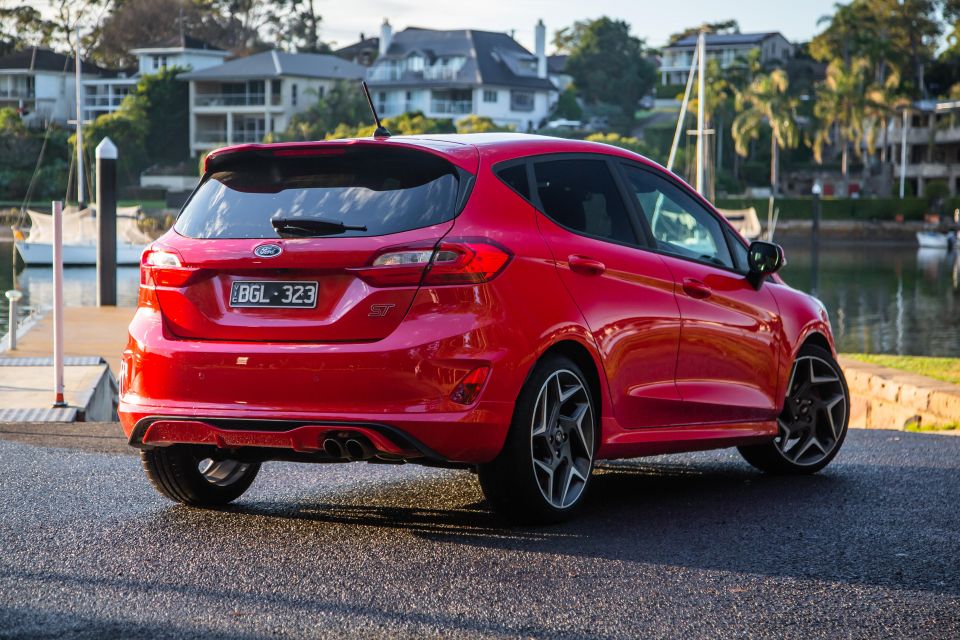

Journalist
New from
$31,990
excl. on-roads

Journalist
New from
$31,990
excl. on-roads


Journalist
New from
$31,990
excl. on-roads

Journalist
New from
$31,990
excl. on-roads
Quickly see how this car stacks up against its competition. Select any benchmark to see more details.
Where expert car reviews meet expert car buying – CarExpert gives you trusted advice, personalised service and real savings on your next new car.
How much driver-focused fun factor could a price-busting three-cylinder compact hatchback possibly pack? In the case of the latest 2020 Ford Fiesta ST – a surprising amount.
Don’t let the somewhat familiar façade fool you. This third ‘WG’ stab at the increasingly iconic ST nameplate is a comprehensively remade machine. And as it turns out, it’s certifiably better in every way than the old and fairly popular sixth-gen ‘WZ’ version, put to pasture in 2018.
Given the newcomer’s $4800 price hike, it ought to be.
After a week living with what I discovered is a highly-liveable all-rounder, its new low-$30,000 ask certainly seems justifiable. That’s because the German-sourced, Green Hell-tuned, manual-only prospect delivers the right stuff where it counts: a driver’s tool clearly stitched together by petrol heads for petrol heads.
For it’s sub-small-segment stature, the new Ford Fiesta ST delivers ‘classic’ hot hatch fun in big doses. Launch control and heated steering wheel notwithstanding…

Is it the nicest, most balanced, more upmarket compact hot hatch out there? Not in the company of Volkswagen Polo GTI. But the Fiesta ST is more about thrills and grins than it is measured balance, the sort of device that entices you to detour via a hilly pass, a racetrack or any handy set of curves between you and the supermarket carpark.
And more so than anything else in its rarified class
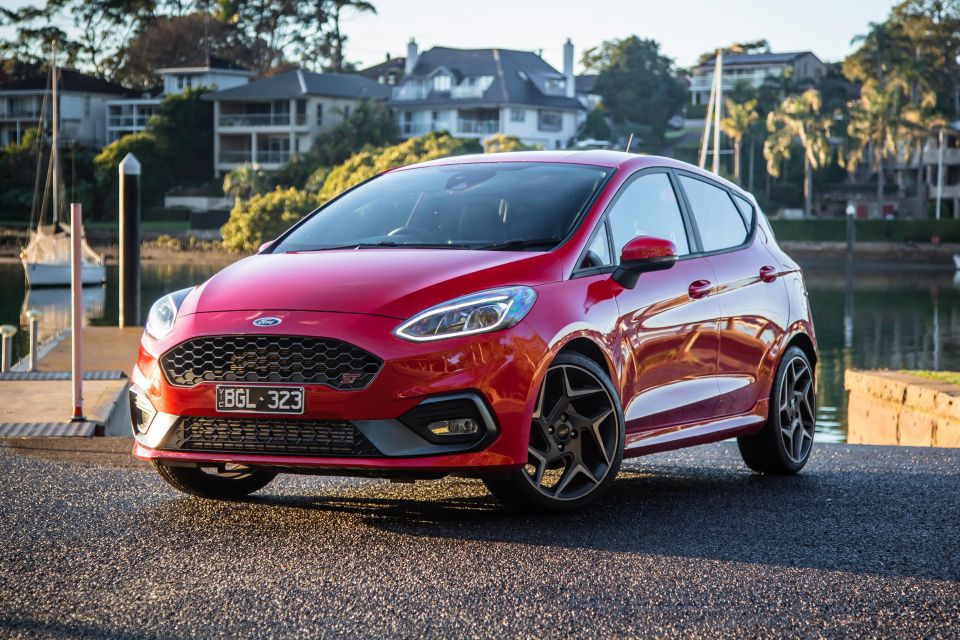
The Fiesta ST arrived in Oz in April this year at $31,990 before on-roads, one variant fits all, unlike in the three-strong range offered elsewhere in Europe. It’s since nudged up a touch to $32,290 before on-roads. The old generation left showrooms 12 months prior at a much thriftier $27,490.
What else would low-$30,000 get you? As a micro segment of sorts, the Abarth 595 Competizione hatch (-$300) and Volkswagen Polo GTI (+$600) are both on the money, though only the Italian offers a good old conventional manual format. Renault’s Clio RS 200 Cup (+$200)? Get in quick as it’s being axed.
For smaller, lighter, cheaper and less-potent thrills, you could always opt for the well-regarded wallet-busting Suzuki Swift Sport ($26,990 list), though it’s a bit lukewarm in this company.
White and red – as tested – are standard colours, while a choice of four silver/grey/black metallic or Ford’s signature Performance Blue command an extra $650. A choice of two matte racing stripe designs, with black or red borders, can be added at $451 for bonnet and front bar, or $749 with the addition of roof stripes.
The alloy gear knob can be swapped for carbon-fibre for $350, while the sole big-ticket option is a $2500 panoramic sunroof.
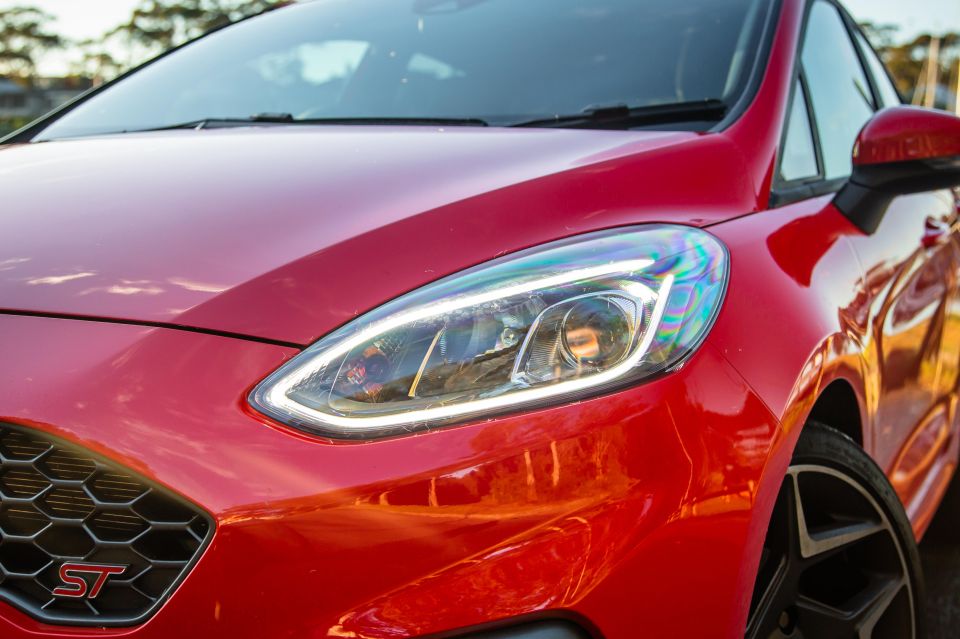

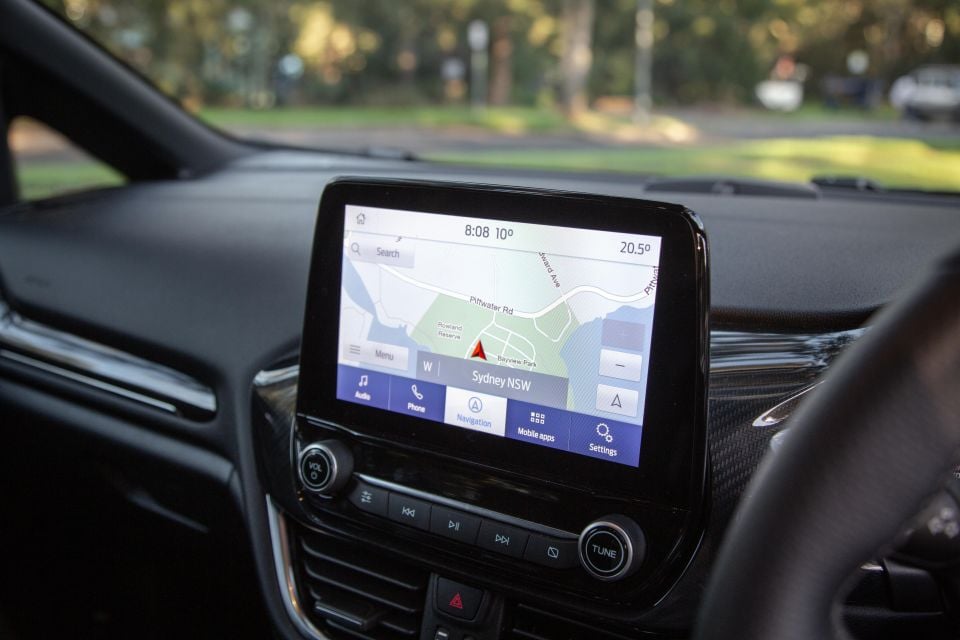
Buy your new car without the stress. It's fast, simple and completely free.

Great service from Travis and team, second time I have used this business would not hesitate to recommend them to anyone
Craig C.
Purchased a Ford Ranger in Sunshine Coast, QLD
CarExpert helped Craig save thousands on his Ford Ranger, now let us save you on your next new car.
Find a dealThe headline upgrade to the ST centre around improved power/performance and tech, so let’s knock off the go-faster stuff first outside of the engine itself.
Wheels are up in size to 18s from 17s shod with excellent 205mm Michelins Pilot Sport 4s and significantly improve Fiesta ST’s appearance, augmented by specific bumpers, grille, side skirts, rear spoiler, exhaust outlets and, of course, badging.
It gets a specific suspension tune and new for breed is the fitment of a mechanical limited-slip differential. Torso-hugging Recaro race-style bucket seats, launch control, in-dash upshift lights and bimodal exhaust smarts with active sound enhancement, for more raucous sonics in Sport and Track drive modes, are par for the ST course.
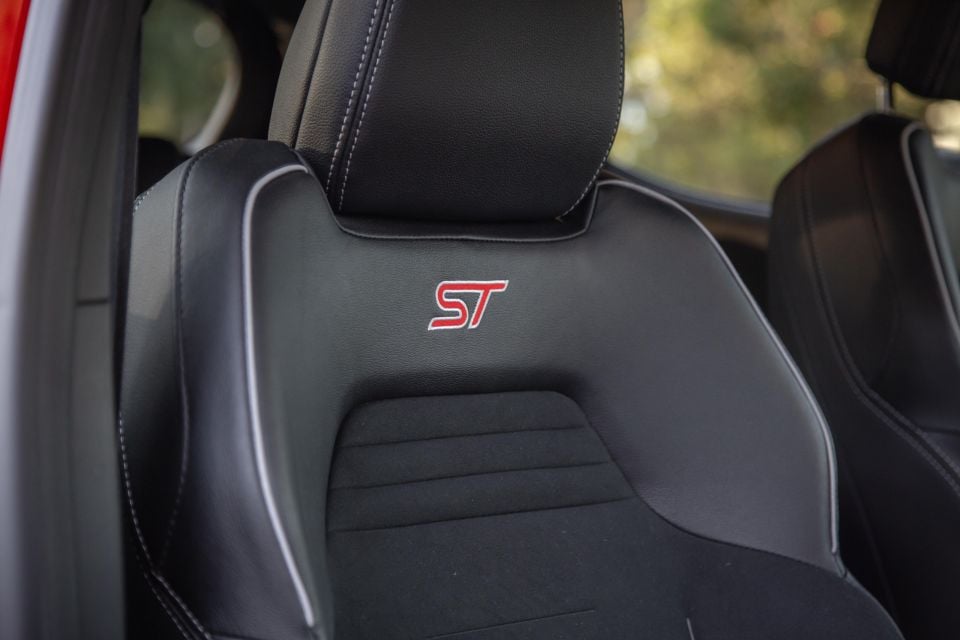
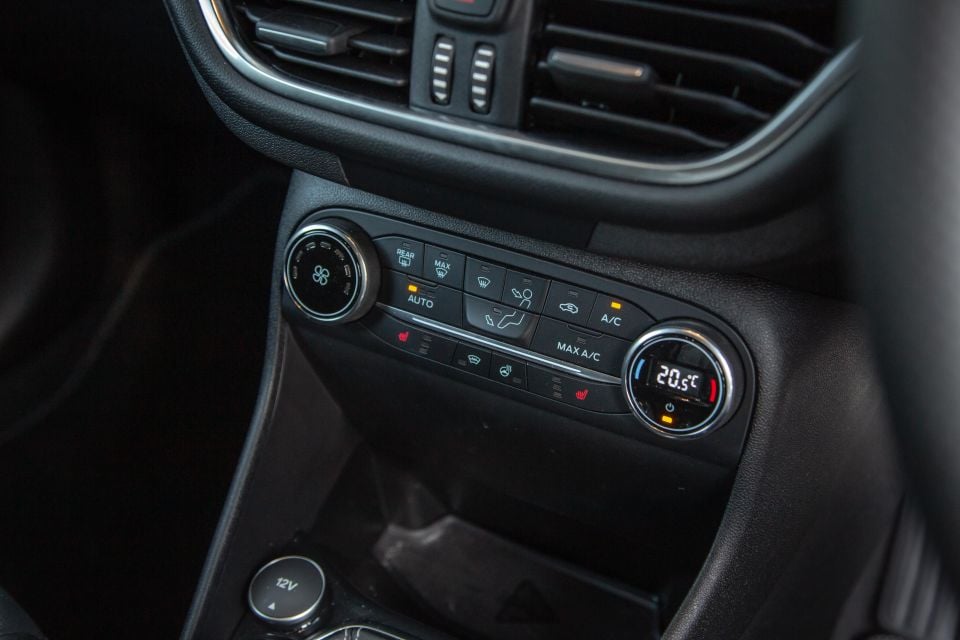
Elsewhere, the ST has dusk-sensing LED projector headlights with auto high-beam, LED tail lights and daytime running lights, heated/power-folding mirrors and ‘heated windscreen’ that uses fine wire elements rather than de-mister air-conditioning.
Sporty tweaks inside include alloy touch points and highlights, carbon-fibre-look inlays and a leather-wrapped flat-bottom wheel are standard. The Recaro front seats are full mechanical and feature leather and suede trim.
Infotainment is Ford’s familiar 8.0-inch touchscreen system with Sync 3, which features Apple and Android phone mirroring, DAB+, proprietary sat-nav, an adaptively guided reversing camera, and Bang & Olufsen Play audio with 10 speakers.
Rain-sensing wipers, cruise control, one-touch electric windows, ambient lighting, an auto-dimming mirror, a tyre pressure monitor, rear sensors, a remote key and both seat and steering wheel heating all prop up what’s one quite elaborately equipped little five-door.
Sadly, the smart-looking three-door versions offered in Europe haven’t been slated to make the trip across the pond.

While much of Ford’s wider range – including Focus ST – has earned five-star ANCAP ratings featuring largely similar safety kit, the Fiesta ST has thus far remained unrated by the local assessment program.
The non-ST Fiesta wears a 2017-dated five-star Euro NCAP safety rating, for reference.
Functionality notwithstanding, the actual features fitted make for a promising prospect. Its AEB system features pedestrian and cyclist detection while its suite of active assistance includes forward collision and lane departure warning, lane keeping, blind spot monitoring and rear cross traffic alert systems, the latter with handy auto braking.
Speed sign recognition and hill start assist are nice inclusions and it fits front occupant and side curtain airbags across both seating rows.
As go-fast grocery getters go, you could do a lot worse.
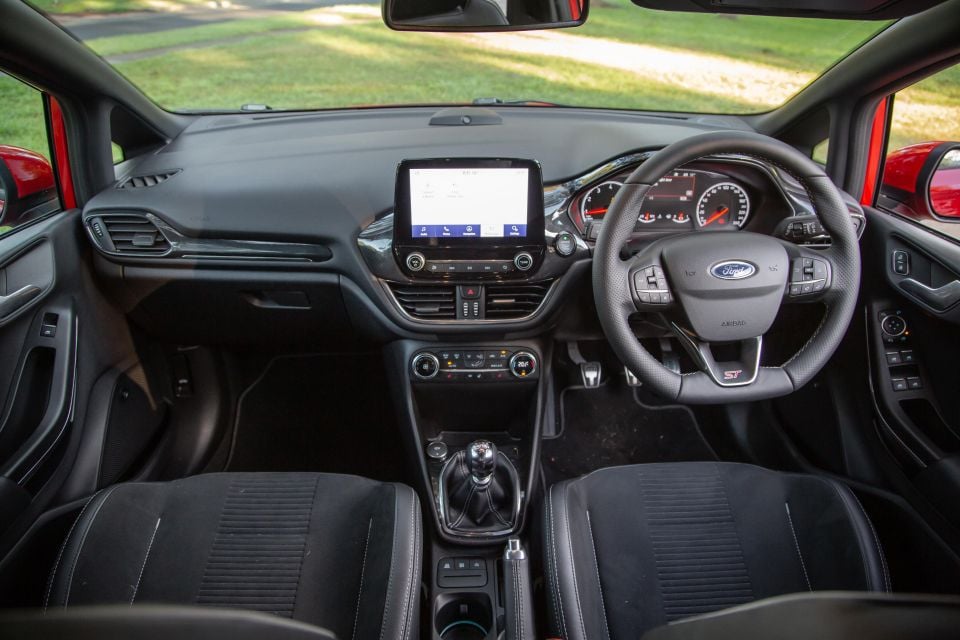
Though quite reminiscent of its last generation, the newcomer’s slightly longer and wider restyled body in conjunction with larger rolling stock do wonders for improving upon the older version’s arguably dumpy appearance.
Inside, though, there’s a conspicuous upmarket lift and keener sense of celebration. It’s a noticeable improvement on old, if still short on feeling properly premium. The lashings of carbon-fibre (look), alloy, leather and faux suede only distract so much from excessive use of hard and shiny plastic surfaces.
You don’t so much sit as wedge yourself into the heavily bolstered Recaros that are purposeful and clearly the cabin’s crown jewels. The newfound scope of seat adjustment is a huge improvement over the high-perched buckets in the old car, offering perfect driver ergonomics with just the right amount of under-thigh support.
The chunky wheel is well sized and the gear shifter is almost comically short in height with a crisp throw for what’s a nice, cleanly gated mechanism.
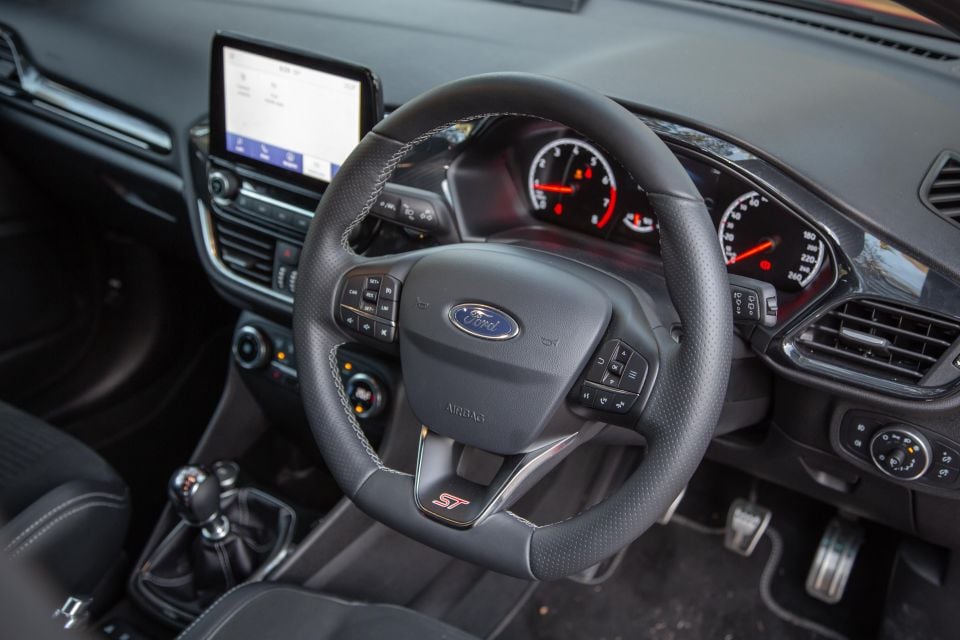

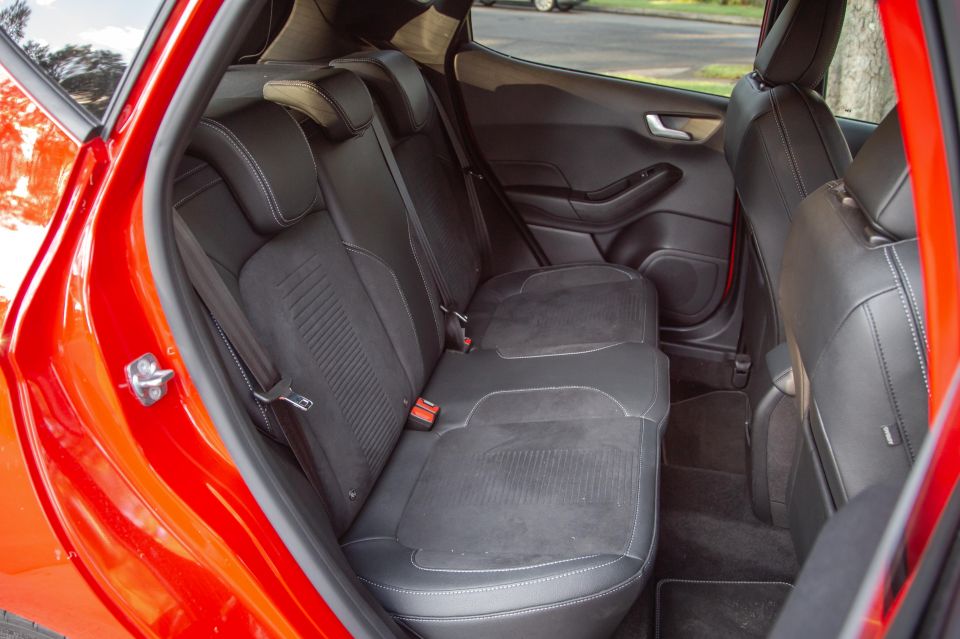
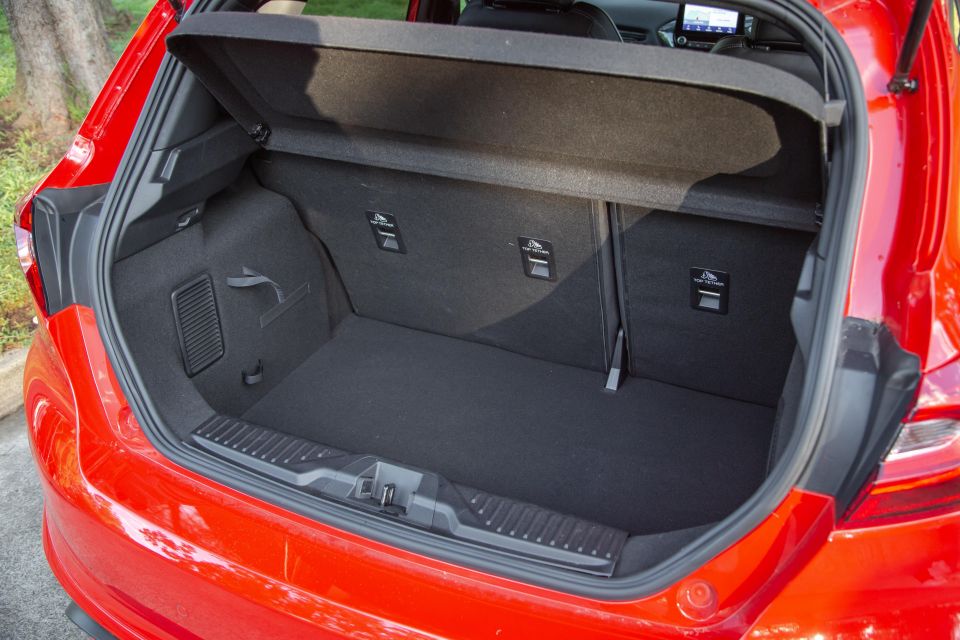
Ford’s Sync 3 infotainment does what’s stated on the tin with no glitches or foibles and, bar an ST logo on start-up, is largely indistinguishable from other models. Ditto the clear analogue instrumentation with clear digital speedo in its central screen.
Neither the USB port just ahead of gearstick, where cables can foul your shifting hand, or the other tucked in the bottom of the tiny console bin are ideally located, though this is a small gripe.
Dimensionally, the Fiesta ST isn’t realistically any smaller than my household’s Mk V Golf GTI, though in cursory comparison the Ford’s not nearly as smartly accommodating in row two. It’s cramped. Really cramped.
You can shoehorn three adults in with the front passenger seat jammed forward though, realistically, if four-adult spaciousness is top priority best direct your attention Focus ST’s way instead. There are no air vents, device power or centre armrest in the back either.
The 60:40 split-fold seating, outboard ISOFIX mounts and boot space grown to 311 litres from the old car’s 276 litres all provide a reasonable about of everyday utility for a compact pocket rocket clearly not out to win you over on sheer practicality.
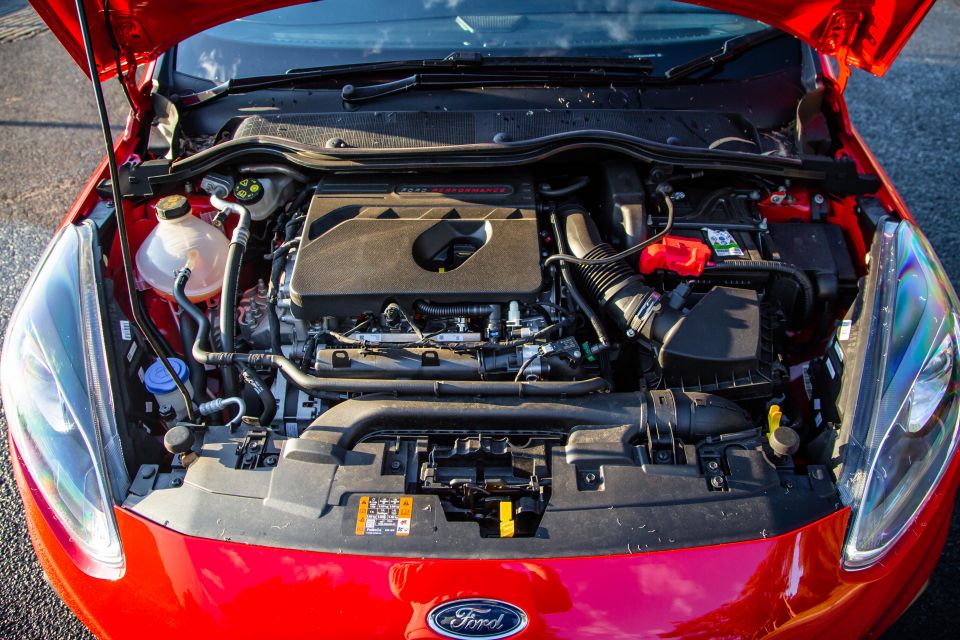
Three cylinders and 1.5 litres. These two stats will be mental hurdles for some hot hatch tyre-kickers. But give the little Ecoboost half a chance and its character and willingness will probably win you over. This three-pot is a cracker of an engine.
It produces 147kW at six grand and a fulsome 290Nm at 4500rpm, the levels of output you expect from a larger 2.0-litre four and, sure enough, on par with rival Polo GTI. These are quite healthy numbers in something that weighs just 1218kg.
Importantly, it feels like a more substantial engine than its capacity suggests. The low-to-mid-range pulling power, be it uphill or in a short-shifter gear, is quite impressive. The three-pot is no highly-strung firecracker – its energy is broad and flexible, and you can be lazy with the cog-swapping if you wish.
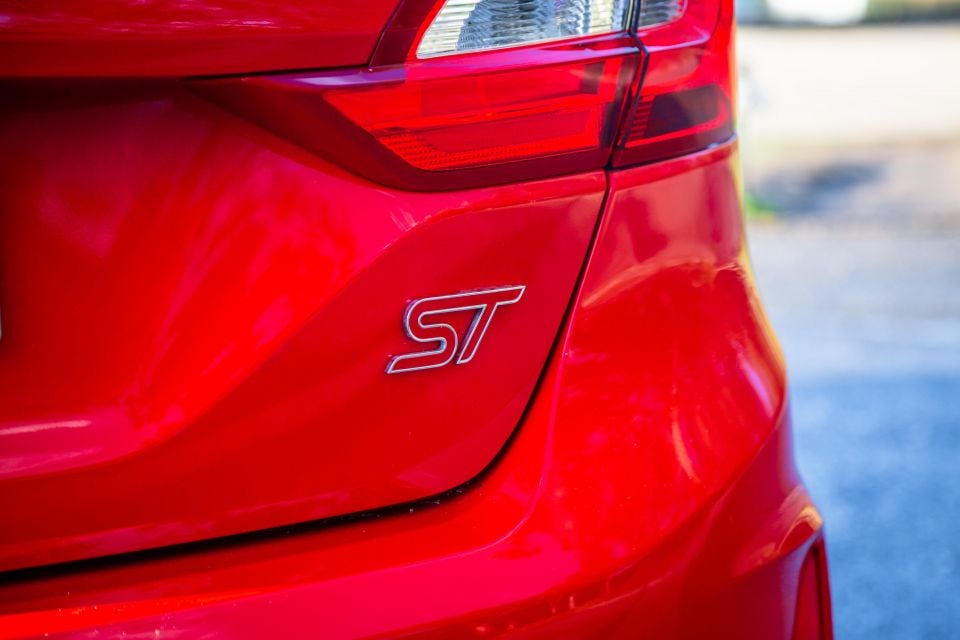
Neglect launch control’s 3000rpm precipice – besides, who’s going to activate such a system punting around the ‘burbs? – and the Fiesta ST will lay down a load of wheelspin while its mechanical LSD attempts to keep traction in check.
Quick? Ford claims 6.5 seconds for the 0-100km/h and provided those Michelins make decent purchase into the hotmix it feels as quick.
Better yet, the gearbox ratios aren’t stacked excessively short to exacerbate the ST’s off-the-mark punch. In fact, the six-speed powertrain has impressively long legs, so much so that the Fiesta ticks along at 110km/h at a cruise in top gear with just around 2500rpm on board.
Combined consumption is advertised at around the mid-sixes and we saw a spread of between sub-fives and tens depending on driving conditions for an average of seven litres neat. That’s okay for a 1.5-litre engine if outstanding for a three-pot with as much energy as this one doles out fairly effortlessly.
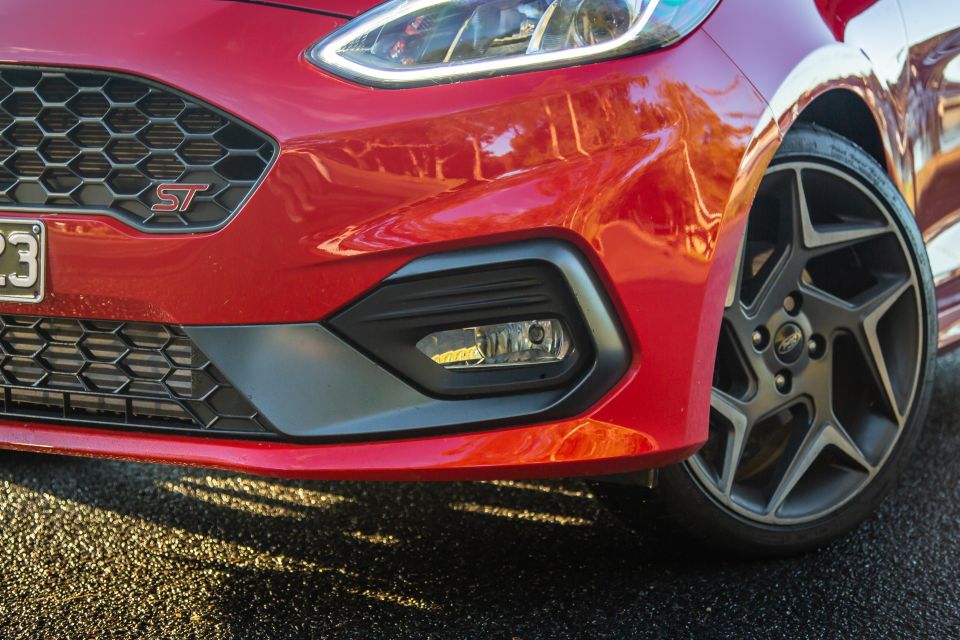
If I were to describe the Fiesta ST driving experience in one word, it would be ‘nuggety’. Those chunky seats, the meaty steering, its generally taut manner and an engine much more fulsome in delivery than you’d expect – this is no flimsy little five-door tin can. Or, at least, it certainly doesn’t feel as much.
It feels solid, tight and glove fit without the sort of agricultural vibe you sometimes find nicely chiseled small cars. The Fiesta ST is evenly tempered and nicely resolved when punting around town, with enough burble and edge to constantly remind you it’s keen for a go while never feeling like it’s straining against the leash.
It sounds good, too. There’s a nice bassy thrum in normal, a bit of artificially enhanced bark in Sport, but none of those ostentatious ‘pop and crackle’ histrionics that become tiresome in ownership and make your neighbours want to throw rocks in your general direction.
The directness of the excellent steering and eager front-end point conspire with the taut suspension for a go-kart like nimbleness that’s alive but not alarming. It stops short of feeling too highly strung.
It’s quite even in its response to driver inputs, particularly the front end point, general chassis balance and the throttle calibration. That said, not everything feels precisely tuned: low-speed braking can be a little abrupt and the slightly vague clutch bite point takes a little bit of acclimatisation.
Ride wise, it’s quite decent around town, though out on the open road there’s a lot of vertical movement across lumps and bumps and the rubber does make a fair racket over anything other than smooth asphalt.

But show Fiesta ST a succession of decent curves, whatever the surface, and it confidently delivers on that classic hot hatch promise. It feels quick and engaging at a pace that won’t risk your licence, the wonderful engine doesn’t overpower the wondrously obedient dynamics, and it simply gets better and better the more you push on.
Better yet, you don’t have to grab its scruff too hard in order to coerce its dynamic best, such is its cooperation to the driver’s whims. And yet should you choose manhandle the Fiesta ST, there’s serious depth in the chassis’s ability to respond with utmost confidence.
Sport mode is plenty ‘alert’ enough for spirited on road driving, too, leaving the loose and lively Track mode calibration for the forum intended.
If there’s any area a little under-baked in this well-cooked package it’s the brakes. I’ve been told they don’t quite have adequate staying power for relentless track day theatrics – we didn’t test this claim – though our test car did generate some faint braking squeal after a sunny Sunday back-road outing.
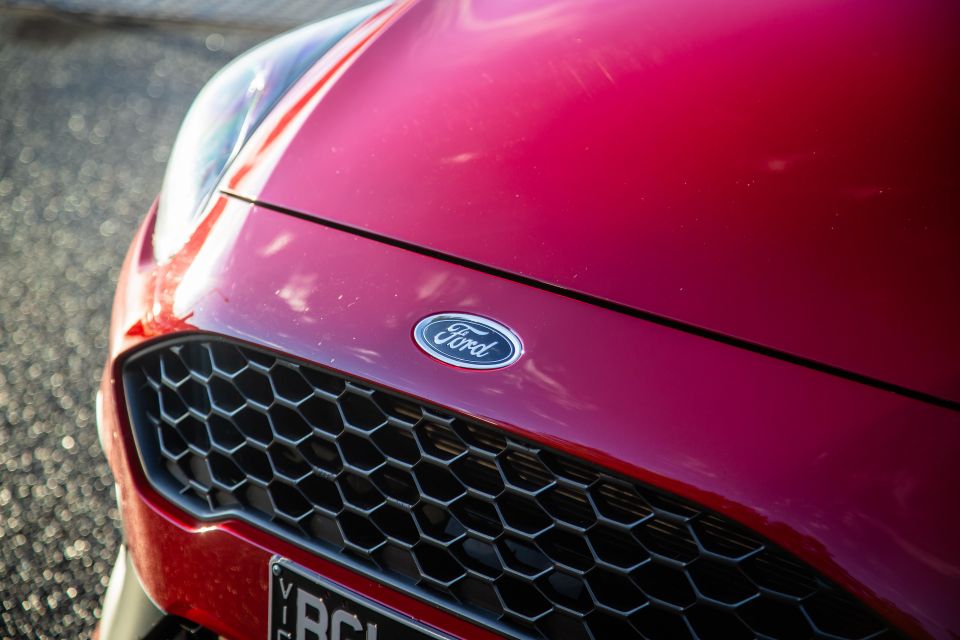
Ford is currently offering five years of unlimited-kilometre warranty on Fiesta ST, as well as $299 per visit capped-price servicing for up to 48 months/60,000kms on a 12 month/15,000km schedule.
That’s pretty cheap for a performance-bred machine built for a bit of red-misted punishment.

Where expert car reviews meet expert car buying – CarExpert gives you trusted advice, personalised service and real savings on your next new car.
Sure, the Ford Fiesta ST could be nicer in some ways. But where this Ford charms most is that its main focus on delivering a genuine hot hatch vibe and performance first and foremost. It’s undoubtedly engineered and tuned specifically for that role.
And yet what actually makes this new version measurably better than the old version is that it’s also more grown up, has more all-round polish and is more enjoyable in day-to-day terms.
Faultless? No. But it’s well close to being exactly what it should and promises to be. And while it took its sweet time getting into Aussie dealerships after going on sale overseas two years ago, our single, high-spec, safety-laden version certainly seems to have been well worth the wait.
Where expert car reviews meet expert car buying – CarExpert gives you trusted advice, personalised service and real savings on your next new car.


Damion Smy
10 Hours Ago


Damion Smy
11 Hours Ago


Damion Smy
13 Hours Ago


Damion Smy
14 Hours Ago


Damion Smy
16 Hours Ago


Damion Smy
17 Hours Ago